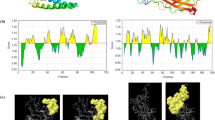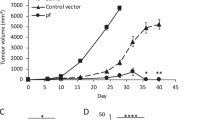Abstract
Prior studies have revealed the immunotherapeutic properties of a vaccine prepared by transfer of genomic DNA from breast cancer cells into a highly immunogenic cell line. The rationale for this type of vaccine is that genes specifying an array of weakly immunogenic, unique tumor antigens associated with the malignant cells will be expressed in a highly immunogenic form by the transfected cells. Here, the immunotherapeutic properties of a vaccine prepared by transfection of mouse fibroblasts with DNA from a breast carcinoma (SB-5b) that arose spontaneously in a C3H/He mouse (H-2Kb) were tested in mice with intracerebral breast cancer. To augment their nonspecific immunogenic properties, before DNA transfer, the fibroblasts (of C3H/He mouse origin) were modified to express allogeneic MHC class I H-2Kb-determinants and to secrete IL-2, IL-18 or GM-CSF. The results indicate that C3H/He mice injected intracerebrally (i.c.) with the breast cancer cells and syngeneic/allogeneic-transfected fibroblasts modified to secrete IL-2 survived significantly longer (P<.005) than mice in various control groups, including mice injected i.c. with the breast cancer cells alone. The immunotherapeutic properties of transfected fibroblasts modified to secrete IL-18 or GM-CSF were less efficacious. The results of two independent in vitro cytotoxicity assays indicate that systemic cellular antitumor immunity was generated in mice injected i.c. with the transfected cells, and the immunity was mediated predominantly by CD8+ T cells.
This is a preview of subscription content, access via your institution
Access options
Subscribe to this journal
Receive 12 print issues and online access
$259.00 per year
only $21.58 per issue
Buy this article
- Purchase on Springer Link
- Instant access to full article PDF
Prices may be subject to local taxes which are calculated during checkout




Similar content being viewed by others
References
Ogura M, Mitsumori M, Okumura S, et al. Radiation therapy for brain metastases from breast cancer. Breast Cancer. 2003;10:349–355.
Bendell JC, Domchek SM, Burstein HJ, et al. Central nervous system metastases in women who receive trastuzumab-based therapy for metastatic breast carcinoma. Cancer. 2003;97:2972–2977.
Sampath P, Hanes J, Dimeco F, et al. Paracrine immunotherapy with interleukin-2 and local chemotherapy is synergistic in the treatment of experimental brain tumors. Cancer Res. 1999;59:2107–2114.
Dranoff G . Cancer gene therapy: connecting basic research with clinical inquiry. J Clin Oncol. 1998;16:2548–2556.
Dranoff G . The use of gene transfer in cancer immunotherapy. Forum. 1998;8:357–364.
Horton HM, Anderson D, Hernandez P, Barnhart KM, Norman JA, Parker SE . A gene therapy for cancer using intramuscular injection of plasmid DNA encoding interferon alpha. Proc Natl Acad Sci USA. 1999;96:1553–1558.
Hiroishi K, Tuting T, Tahara H, Lotze MT . Interferon-alpha gene therapy in combination with CD80 transduction reduces tumorigenecity and growth of established tumor in poorly immunogenic tumor models. Gene Therapy. 1999;6:1988–1994.
Ferrantini M, Giovarelli M, Modesti A, et al. IFN-alpha 1 gene expression into metastatic murine adenocarcinoma (TS/A) results in CD8+ T cell-mediated tumor rejection and development of antitumor immunity. Comparative studies with IFN-gamma-producing TS/A cells. J Immunol. 1994;153:4604–4615.
Yu JS, Wei MX, Chiocca EA, Martuza RL, Tepper RI . Treatment of glioma by engineered interleukin 4-secreting cells. Cancer Res. 1993;53:3125–3128.
Zitvogel L, Tahara H, Robbins PD, et al. Cancer immunotherapy of established tumors with IL-12. Effective delivery by genetically engineered fibroblasts. J Immunol. 1995;155:1393–1403.
Osaki T, Hashimoto W, Gambotto A, et al. Potent antitumor effects mediated by local expression of the mature form of the interferon-gamma inducing factor, interleukin-18 (IL-18). Gene Therapy. 1999;6:808–815.
Lo CH, Lee SC, Wu PY, et al. Antitumor and antimetastatic activity of IL-23. J Immunol. 2003;171:600–607.
Disis M, Cheever MA . HER-Z/neu protein: a target for antigen-specific immunotherapy of human cancer. Adv Cancer Res. 1997;71:343–371.
de Zoeten E, Carr-Brendel V, Markovic D, Taylor-Papadimitriou J, Cohen EP . Treatment of breast cancer with fibroblasts transfected with DNA from breast cancer cells. J Immunol. 1999;162:6934–6941.
Kim TS, Russell SJ, Collins MK, Cohen EP . Immunity to B 16 melanoma in mice immunized with IL-2- secreting allogeneic mouse fibroblasts expressing melanoma-associated antigens. Int J Cancer. 1992;51:283–289.
Yamada G, Kitamura Y, Sonoda H, et al. Retroviral expression of the human IL-2 gene in a murine T cell line results in a cell growth autonomy and tumorigenicity. EMBO J. 1987;6:2705–2709.
Cobere-Garapin F, Horodniceanu F, Kourilsky P, Garapin A . A new dominant hybrid selective marker for eucaryotic cells. J Mol Biol. 1981;150:1–14.
Wigler M, Pellicer A, Silverstein S, Axel R, Urlaub G, Chasin L . DNA-mediated transfer of the adenine phosphoribosyltransferase locus into mammalian cells. Proc Natl Acad Sci USA. 1979;76:1373–1376.
Kim TS, Cohen EP . Interleukin-2-secreting mouse fibroblasts transfected with genomic DNA from murine melanoma cells prolong the survival of mice with melanoma. Cancer Res. 1994;54:2531–2535.
de Zoeten EF, Markovic D, Cohen EP . An optimum anti-melanoma response in mice immunized with fibroblasts transfected with DNA from mouse melanoma cells required the expression of both syngeneic and allogeneic MHC-determinants. Gene Therapy. 2002;9:1163–1172.
Lichtor T, Glick RP, Tarlock K, Moffett S, Mouw E, Cohen EP . Application of interleukin-2 secreting syngeneic/allogeneic fibroblasts in the treatment of primary and metastatic brain tumors. Cancer Gene Ther. 2002;9:464–469.
Lichtor T, Glick RP, Cohen EP . Approaches to the treatment of brain tumors using cytokine-secreting allogeneic fibroblasts. Cancer Therapy. 2003;1:109–120.
Acknowledgements
This work was supported by a grant from the CINN foundation awarded to Drs Lichtor and Glick, and by NIDCR grant number 1 RO1 DEO13970-O1A2 awarded to Dr Cohen.
Author information
Authors and Affiliations
Corresponding author
Rights and permissions
About this article
Cite this article
Lichtor, T., Glick, R., Lin, H. et al. Intratumoral injection of IL-secreting syngeneic/allogeneic fibroblasts transfected with DNA from breast cancer cells prolongs the survival of mice with intracerebral breast cancer. Cancer Gene Ther 12, 708–714 (2005). https://doi.org/10.1038/sj.cgt.7700832
Received:
Published:
Issue Date:
DOI: https://doi.org/10.1038/sj.cgt.7700832
Keywords
This article is cited by
-
Gene therapy for carcinoma of the breast
Cancer Gene Therapy (2006)



